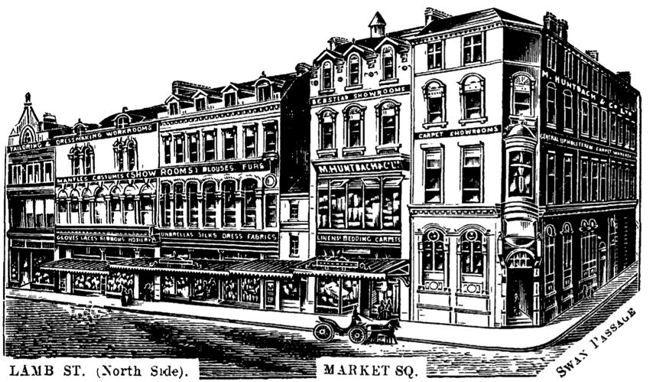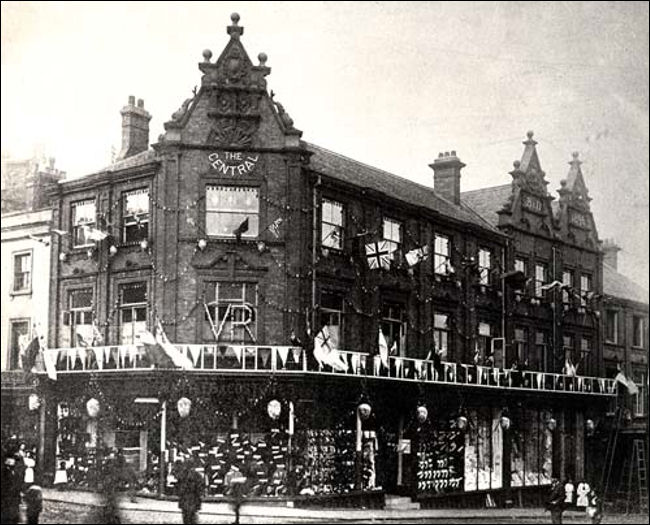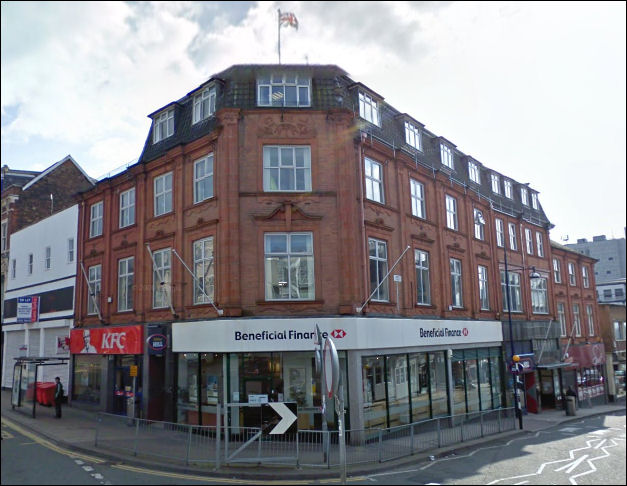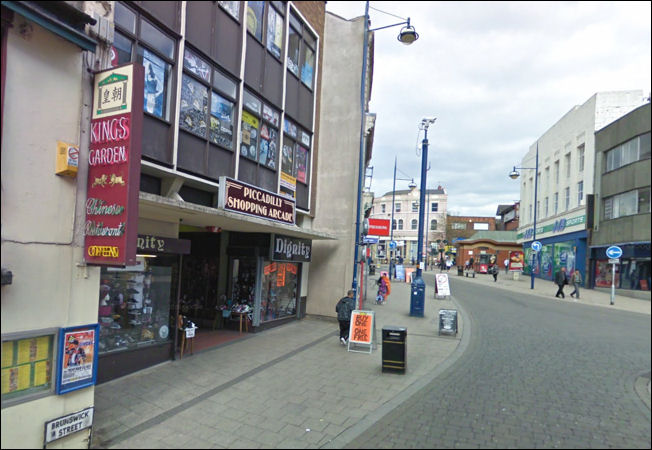|
Hanley got there first in
size and quality
These days the oft heard complaint that Hanley gets more money pumped into it than the rest of the Potteries seemingly causes more irritation and bad-feeling than any other single issue. The Sentinel’s letters’ pages frequently flourish with vitriol that is directed against Hanley – Hanley gets to eat iced cake while the rest of the Potteries munch on stale bread is a common form of comparison.
Often the answer to perplexing questions such as territorial sharing and the equal distribution of assets lies in history. It is so in this case. And the plain facts are that Tunstall, Burslem, Longton, Fenton and Stoke were built around pot banks, workplaces that still remain a feature of those towns. Hanley, on the other hand, also was built on clay and coal but cleverly got rid of its town centre factories when its civic fathers decided that retail and commerce were more fitting to fashionable success.
To paraphrase a useless aphorism about familiarity breeding contempt – I think I can say that long gone are the days when parochialism bred content. And yet it seems that even in our times each of the Potteries ‘other’ Towns still want to be a Hanley. But alas for them, and unquestionably fortunate for everyone else – they can’t because Hanley got there first in size and quality.

Huntbach’s store, Lamb Street, Hanley
picture: 1907 Sentinel directory
The die was cast in 1876 when Michael Huntbach acquired the shop of Charles Vyse in Lamb Street, a true-tale fictionalised, thinly disguised and superbly told by Arnold Bennett in his short story, The Feud. In a commercial move we would take for granted these hi-tech and retail pressurised days, this shrewd business deal saw Huntbach buying-up the remaining surrounding properties en-bloc in order to open Hanley’s first superstore.
When he died in 1910, ironically the year of Federation, Huntbach’s store then occupied more than 20,000 square feet of space and employed 300 staff. Big retail had arrived; the other towns would never have a look in and there was no turning back for Hanley.

Bratt and Dyke on the corner of Stafford Street and Trinity Street
picture: Staffordshire Past-track

the only building of the
three big department stores that survives today
Google Street View 2011
Another big-thinking shop owner was Oliver Dyke a draper who founded the department-store, Bratt and Dyke, adding-to and extending the business around the corner of Stafford Street and Trinity Street by scandalously buying the historic Roebuck public house and, irrespective of its excellent trade and all opposition, knocking it down!
The Bratt and Dyke emporium had been adapted through growth that no one was quite sure just how many floors it occupied and which staircase led to which department. And just how many of the Potteries young children had got lost wandering from the school uniform section while searching for the extensive toy department hidden away somewhere in the vicinity of the household draperies where its mother had herself distractedly strayed, will neer be known.

McIlroy’s store continued the standard until it was replaced by Lewis’s
store
postcard: John Booth
Both these famous local stores have passed into history but their pioneering insight has been adopted and adapted by later generations.
McIlroy’s store continued the standard until it was replaced by Lewis’s store, mostly set in Stafford Street; a formidable trading leviathan that became bigger than both its predecessors, a site now occupied by Debenhams within the domain of the Potteries Shopping Centre.
Lewis’s was the first store in the Potteries to use an arcade, a very European Art-Deco innovation popularised in Paris in the first half of the 19th century. Arcades were indoor pedestrian shopping alleys that provided comfortable and stylish swish and a safe shopping environment away from the dirt and clutter of the street, away from adverse weather conditions.
Lewis’s chrome and glass arcade is still remembered with affection.
Hanley grew slowly, then fast as trading fashions changed. Barry Blaize, in his excellent tributes to Potteries’ cinemas, catalogues the development of cinematographic pastime and culture. In his comprehensive history, The Lost Empires, the author lists nine cinemas that thrived in Hanley during the 20th century.
One of the first cinemas in the Potteries was the Empire Electric Theatre whose front entrance was in Brunswick Street with another entrance located in Trinity Street right next door to Bratt and Dyke’s. The setting was provocatively close to the Grand Theatre of Varieties – later renamed the Theatre Royal – and surrounded by 15 public houses. Today (2004) the Theatre has become the Liquid night club and the traditional 15 pubs have dwindled to just two.
In the later years of the 1950’s the established concepts of cinema were changing rapidly with the advent of television, and in the following decade many were turned into bingo halls. Hanley’s Empire was already doomed by then and it acquired the uniqueness of being Hanley’ first cinema to open and the first to close. Barry Blaize writes,
“When it closed in 1956 it was one of forty cinemas that the Rank Organisation considered to be uneconomical,” prophesy that Rank played out until the company itself turned to the more competitive gaming business. The thing that provoked the indifferent community was what to do with the Empire site. And even in those austere times planners recognised that something special should be done with the site.
As one door shuts, as they say, another opens when overnight the Empire Electric Theatre became the Piccadilly Arcade utilising both cinema entrances and lining the main auditorium with shops as a market thoroughfare. It is still special today and retains nostalgic memories of the Hanley of half a century ago.
At one end of the 80-yard long arcade a specialist clothes and accessories’ shop is doing good business. At the other end arcade a specialist clothes and accessories’ shop is not doing such good business. Both shops cater for a distinctive and particular clientele and trade in totally different styles. World’s apart in fashion and yet just a few footsteps separates the two shops.
At the Trinity Street entrance ‘Kimberley’s’ is a ladies fashion shop that specialises in women’s sizes 16-30, creating, I would have thought, a well-frequented outlet.
“You could be forgiven for thinking that,” says the owner Kimberley Corbett. “The truth is my business is struggling and I will not be renewing my lease next time round. There has been a marked decrease in sales because of the concentration of shops in the town centre, and particularly in the Potteries Shopping Centre. Obviously the central location takes the best business.”
Kimberley has been operating in the arcade for six years. “Another problem I have is with the number of new nightclubs that have been allowed to open around here. People who are my natural customers just won’t venture down the street anymore.
Have a look around,” Kimberley gestured me to examine a couple of empty units. “A lot of the businesses that were in Trinity Street have packed up and left. Nobody will put up with all the drunkenness and mess that’s left here after each weekend. I can’t afford to stay any longer and I can’t afford to move into the town centre with rents as high as £60,000 a year.”

the Brunswick Street end
of the Piccadilly Shopping Arcade
At the Brunswick Street end is ‘Dignity Shoes’ owned by Jas Johal.
“I originate from India,” says Jas. “I’ve been in business in Hanley for ten years mainly selling shoes. I’ve always moved with the trends because clothing is forever about changing current fashion.”
Fetish or straight: Dignity is a veritable goldmine for leather – tight leather with straps and metal buckles. In Dignity you can buy New Rocks and unisex boots; boots that are covered in sexy furry stuff. Boots with three inch soles with exposed metal springs built into them; Harley Davidson boots and patent leather spiked knee boots interchangeable with leopard-skin accessories: and the price – a pinch at £268 – guaranteed to pinch the purse but not the toes.
Despite Kimberley’s pessimistic view, this is Hanley at its best. Next door is ‘Avalon’ gift shop, a fun shop that sells specialist toys and presents that wonderfully defy description except that they are non-hi-tech and are not computerised.
There’s a travel agency where you can rest in deep Chesterfield sofas as you flick through brochures for holidays on the moon or in outer space on some distant star base.
‘Elegance’ is a beauty shop where rows of beautiful Potteries’ girls sit in a line having their fingernails groomed by rows of beautiful Potteries’ fingernail hostesses.
The arcade boasts ‘Barnes Blinds,’ where you can have window-fittings designed to match you own personal décor.
And an old friend of the Potteries, Mike Lloyd, now runs a record store that trades in specialist c.d. second-hand exchanges.
Old Oliver Dyke would have been proud at such innovation I’m sure.
Unfortunately Kimberley Corbett seems to be at the wrong end of the arcade – the one furthest away from the Cultural Quarter. Kimberley used to work at Evans’ fashions before starting out on her own.
Her next door neighbour in the arcade, Christopher Skelhorne, once worked for the Potteries most famous jeweller, Pidduck’s before he moved here when the notable horologist closed in 1982.
“I’m perfectly happy here,” says Christopher. “Business is good, but I have a specialist trade with a dedicated clientele. Pidducks was a respected business and I like to think I’ve brought its talents with me.”
Christopher showed me his upstairs workroom and indeed it was like stepping into the past with an ancient workbench with intricate tools and magnifiers. A faint smell of acid hung in the air and strands of metal, which Christopher assured me was gold banding, lay casually around.
“It looks impressive but we move everything out at night. And as far as business is concerned nothing much has changed.” Christopher mused. “I still carry on the family traditions of a family company. Pidduck’s was a family company. I remember my first day at work just after I left school at fifteen. The shop manager Neil Harrison ushered me upstairs to the office where I was interviewed by Eric W Pidduck. ‘You’ll be the new boy,’ he said. Then Eric glanced over his specs, his neck protruding from Dickensian wing-collars. And then he turned to Mr Harrison. ‘See, how much do we pay new boys,’ he asked his top man. ‘Two pounds ten shillings,’ was the reply. ‘And very generous indeed if I may say so,’ responded Mr Eric. ‘Set the boy on.’ And I’ve been in the business ever since.”
Piccadilly Arcade is the perfect place for specialist goods made and sold by special people. I do hope Kimberley’s trade picks up. The Potteries, never mind Hanley, needs elite traders.
Fred Hughes

|
![]()
![]()
